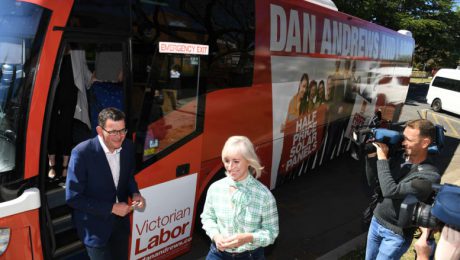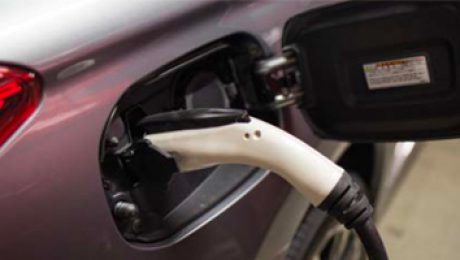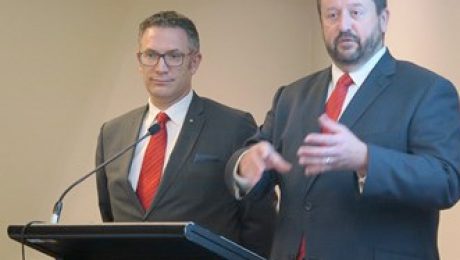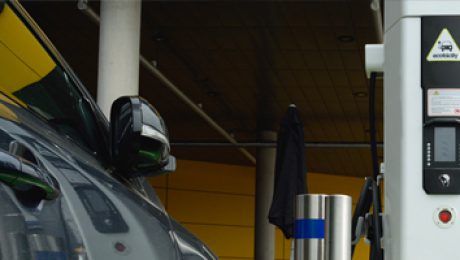New factory to make Morwell ‘electric car capital’ as Labor eyes marginal seat
Labor has struck a confidential deal to build an electric vehicle factory in Morwell, bringing an estimated 500 manufacturing jobs to the Latrobe Valley.
The value of the five-year agreement between the Andrews government and Australian company SEA Electric has been kept secret but the deal has already been signed, meaning it will go ahead no matter the result of next month’s election.
It follows the loss of about 750 jobs in the region when the Hazelwood coal-fired power plant closed early last year.
Latrobe Valley residents who may have lost work when Hazelwood closed will be given the opportunity to train with SEA Electric through the government’s worker transition service.
“The announcement today … is all about making sure the Latrobe Valley is the national capital for electric vehicles,” Premier Daniel Andrews said.
“There will be jobs in the construction of the factory, and of course when you are producing 2400 vehicles a year there are great opportunities for more of that supply chain to be brought into this proud region.”
After spending Monday in his home town of Wangaratta, Mr Andrews boarded his campaign bus for the second day, heading to Morwell to announce the deal on Tuesday.
The seat of Morwell currently belongs to neither Labor nor the Coalition, with former Nationals MP Russell Northe leaving the party to represent the electorate as an independent.
Labor has designated Morwell a target seat, which means it gets a fully resourced field campaign.
The party held Morwell from 1970 to 2006, until Mr Northe won it for the Nationals.
It could be a pivotal seat for the Coalition if it is to defeat the government at the November election.
The Nationals have preselected former Latrobe City councillor Sheridan Bond. Mark Richards, a former Hazelwood employee, is running for Labor.
Former senator Ricky Muir will also contest the seat for the Shooters, Fishers and Farmers Party. Mr Northe, who holds the seat by 1.8 per cent, has not yet declared whether he will fight another election.
The car manufacturing deal was being kept commercial-in-confidence to preserve Victoria’s competitive advantage, Mr Andrews said.
“I think Victorians understand that we can’t be telling all of our competitors and setting the price if you like,” he said. “We need to make sure that we get good value and we have.”
Ben Carroll, the Minister for Industry, said the auto sector would change more in the next five years than it has in the past 50, and the deal would set Morwell up to be part of that change.
A site for construction of the factory is yet to be confirmed, but SEA Electric group managing director Tony Fairweather said it could be up and running within a year.
“We’d hope in around 12 months,” he said.
The company already has a factory in Dandenong where it assembles electric delivery vans and minibuses.
About 2400 electric vehicles would be assembled at the plant annually, with potential to ramp up production in coming years.
Thirty per cent of the vehicles would be made locally, Mr Fairweather said, because some components of electric vehicles are not made in Australia.
But he said there was potential to boost the level of local content as production increases in coming years.
- Published in News, Technology
Work-ready electric waste trucks launched in Victoria
South-east Melbourne’s City of Casey will be the first Australian council to feature a 100 per cent electric truck in operation, with the first residential hard-rubbish waste collection vehicle set for service this month.
Launched at the Waste Expo Australia today in an all-local collaboration, waste management company WM Waste Management Services took delivery of the trucks, which are stripped-back Iveco Acco and Mercedes-Benz Econic cab-chassis fitted with a drivetrain and associated components by Dandenong-based SEA Electric, and a rear loader and compactor built by Queensland-based Superior Pak.
The vehicles contain 220kWh NMC batteries, allowing for a range of about 250 kilometres on a 23,500 gross vehicle mass with a limited top speed of 100km/h.
A 22kW onboard charger allows the truck to be plugged in and charged from any three-phase power source, and a full charge takes eight hours, although rapid-charging options are said to be explored.
The battery life is estimated to be 3,500 charge cycles or operational life of 10 years in day-to-day applications.
WM Waste had previously taken delivery of the first hybrid trucks in 2008 and managing director Mark Jeffs says the company continues to seek out innovation and sustainability in its operations. READ MORE
- Published in Articles, Media Release
Governments must prepare for electric vehicles, inquiry told
The era of the electric vehicle is approaching and the Commonwealth needs the right policies and infrastructure in place, experts say.
A parliamentary inquiry into electric vehicles has heard that electric vehicles will likely be cheaper in Australia than internal combustion engine cars by as soon as 2024.
The falling cost of electric vehicles will drive significant uptake of the vehicles in the near future, according to Ali Asghar, senior associate of power, energy storage and electric vehicles at Bloomberg.
“The cost is falling fast,” Mr Asghar told the inquiry. “Electric vehicles are likely to become cheaper than internal combustion engine cars as soon as 2024. This is mainly a result of cost declines in the major cost component in electric vehicles: batteries.”
Australia’s uptake of electric vehicles to date has been “sluggish” compared to the rest of the world, he said.
“In Australia, the major reasons [for poor uptake] are the cost of electric vehicles, lack of policy measures and then lack of model availability. The lack of model availability is tied to policy measures, because car manufacturers won’t bring in cars to the market if they don’t think that they will be sold here,” Mr Asghar said.
Policy must support uptake
Tony Fairweather, group manager of SEA Electric, told the inquiry that Australia is in the midst of an “electric vehicle revolution” and said governments needed to act fast.
“There is no point putting our head in the sand… the electric vehicle transition is occurring,” he said.
In his submission Mr Fairweather called on the government to introduce measures – such as subsidies, rebates, a zero stamp duty or registration waver – to encourage the uptake of electric vehicles. READ MORE
- Published in Articles, Media Release
Iveco ACCO goes electric!
The Iveco ACCO is not a machine that is normally associated with cutting-edge tech.
But the tried and true Aussie-built offering is suddenly at the forefront of the electric vehicle revolution!
Iveco has just confirmed an ACCO with a fully electric powertrain will be on show at the upcoming ‘Waste Expo Australia’ event in Melbourne.
And this isn’t a concept – you can order your own already!
The model, best known for its decades of service on agitator and waste collection duties, steps into the 21st century with an electric powertrain developed locally by Superior Pak and SEA Electric.
The waste body manufacturer and the Australian electric drivetrain manufacturer have given the ACCO a SEA-Drive™ 180 electric driveline that provides the vehicle with a range of approximately 250 kilometres at full GVM (up to 23.5t).
The vehicle features a 22kW on-board charger allowing the truck to be plugged-in and charged from any three-phase power source.
Battery charging time from totally flat to full charge is approximately eight hours.
Battery longevity is calculated at 3,500 charge cycles, giving it a life of over 10 years based on a single charge, five days per week.
They tell us the remainder of the driveline is virtually maintenance-free.
While the fully-electric ACCO will cost more than a standard diesel model, SEA Electric say operators can recoup the extra outlay through lower operating costs after just four years. READ MORE
- Published in Articles, Media Release
Waste Expo to reveal ground breaking electric trucks in Melbourne
A waste truck propelled by battery electric power will debut at Waste Expo Australia in October.
The IVECO ACCO, a diesel-free waste truck with an electric drivetrain from SEA Electric, is an Australia-first joint project involving waste body equipment specialist Superior Pak.
It will be unveiled at the three-day event to be held at the Melbourne Convention and Exhibition Centre.
The two-in-one body incorporates an industrial cage with electric ramp for lifting white goods and heavy items.
A more traditional compactor body at the rear is designed for use on hard waste collections in the City of Casey in Melbourne.
Available to order shortly following the expo, the ACCO is powered by SEA-Drive 180 electric driveline, featuring a 220kWh NMC batteries.
At a gross vehicle mass of up to 23.5 tonne the vehicle is specified to a range of 250 kilometres at a limited top speed of 100 kph.
The truck can be plugged in via a 22kw on-board charger from any three-phase power source.
A full battery charge takes approximately eight hours.
Battery life has been calculated at 3,500 charge cycles, tantamount to 10 years of service at five days a week.
Rob Wrigley, Superior Pak Managing Director, said the local EV program had been propelled by recent success achieved in a similar project in New Zealand, along with an increased interest in Australia for electric commercial vehicles.
“We’ve had a similar electric powered collection vehicle operating in New Zealand for some time now, and the owners are very pleased with the performance,” he said.
“The payback on the vehicle is attractive as is the low operating costs and lower total cost of ownership.” READ MORE
- Published in Articles, Media Release
SEA Electric opens EV facility in Melbourne
Australian automotive technology company, SEA Electric, has opened a new facility in Melbourne to bolster its electric vehicle production capabilities.
The new location is 13 Advantage Drive, Dandenong South.
SEA Electric has developed a proprietary electric driveline technology for the commercial vehicle sector, with five SEA-Drive drivetrains targeted at electrifying the distribution vehicle segment from delivery vans to 23.5-tonne Gross Vehicle Mass (GVM) 6×4 rubbish/agitator vehicles.
SEA Electric Group Managing Director, Tony Fairweather, said the SEA-Drive technology is unique in a number of ways.
“It has been developed on flexible architecture, allowing both the optimisation of the energy consumption for each sub-system, like air conditioning, while also allowing a framework upon which new developments in sub-system hardware can be introduced and adapted in the future.
“This results in a ‘live’ system, whereby continuous improvement is possible, which ultimately de-risks the purchasing decision for fleet buyers,” he said – adding that mid-mounted batteries provide optimised vehicle balance and future-proofing against expected side impact legislation. “An on-board charger removes the need for external charging infrastructure which is one of the most contentious purchasing issues with EVs. Our SEA-Drive system only requires a standard three-phase, 32A power point to charge, which are readily available in commercial properties around the world and can be installed anywhere at very little cost. We therefore have the largest charging network in the world, as already established.” READ MORE
- Published in Articles, Media Release
QFleet Electric Vehicle Transition Strategy
When the Queensland Government released The Future is Electric: Queensland’s Electric Vehicle Strategy last year, we made a commitment to transition the government fleet to electric vehicles. The QFleet Electric Vehicle Transition Strategy establishes this new technology firmly on the government’s fleet agenda. The current inclusion of electric vehicles in QFleet’s fleet, and the intention to at least double their number each year for the next four years, will demonstrate their suitability as part of a multi-functional and versatile
vehicle pool.
This leadership position will be sustained, and negotiations are alreadyunderway with vehicle manufacturers to pave the way for early access to new electric vehicle models when released onto the Australian market.
With a combined fleet of more than 10,000 vehicles located across the state, departments will have many opportunities to make the shift to electric models as vehicles fall due for replacement over the coming months and years. With their support, this strategy will make the transition a reality.READ MORE
- Published in News
NQR and FSR models with 200-250km range produced in with SEA Electric
Isuzu Australia Ltd (IAL) will test two battery electric vehicles (EVs) it has developed in partnership with Melbourne-based EV developer SEA Electric.
A purely Australian effort, it is independent of Isuzu’s Japan-focused Elf EV light commercial project EV previewed at last year’s Tokyo Motor Show but comes with the blessing of headquarters in Tokyo.
The EV program is focused on proving the 8-9 tonne gross vehicle mass (GMV) NQR and the 12-14 tonne GMV FSR for urban return-to-base applications.
The NQR will have maximum and continuous power of 130kW and 100kW respectively, while those for the FSR are 250kW and 150kW.
Maximum and continuous torque are 1,500Nm and 800Nm for the NQR and 2,500Nm and 1,230Nm for the FSR
Both models will carry 132 KWh nickel, manganese, cobalt oxide (NMC) lithium-ion battery packs powering direct drive permanent magnet motors, rated to 98 per cent efficiency.
The battery type used, sourced from Canada and China, was chosen for its energy density and ability to stay cool enough to avoid flaming. It is expected to have a battery life of 8-10 years.
Read the Full article
- Published in News
Solutions: Transport of tomorrow – The future is electric
The reality of this sector today is that it’s dependent on refined petroleum that enters Australia through import vessels and leaves through tailpipe emissions.
Electric vehicles allow us to address both ends of the equation. While we import more than 92 per cent of our oil requirements, we generate 100 per cent of our electricity domestically. Vehicles that run on that electricity cost a fraction in fuel and maintenance, all while producing zero tailpipe emissions.
Economic improvement, increased public health and reducing pollution are all reasons why the global road transport sector is working in lock step towards a future powered by electric vehicles.
Read the full Article
- Published in Articles, Technology





